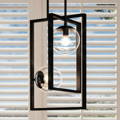The Casual Design Style
Casual design style in residential interior design emphasizes comfort, relaxation, and a welcoming ambiance. Often viewed as the antithesis of formal, stuffy interiors, casual design champions the lived-in look. It's the embodiment of an environment where shoes are kicked off, laughs are shared, and memories are made.
In essence, casual design resonates with homeowners who want their space to be a reflection of their lives – unpretentious, inviting, and replete with personal touches that make a house truly feel like a home.

Casual Style Architecture
Casual design architecture often embody a sense of warmth and approachability. Pitched roofs, expansive windows, and open floor plans are common, inviting natural light and fostering connection between spaces. Exteriors may feature wood or stone while the interior boasts exposed beams, fireplaces, and built-in shelves. The overall intention in casual architecture is to craft a space that facilitates ease, flow, and the simple joys of daily living.
Casual architecture prioritizes functionality, comfort, and an unpretentious aesthetic
Pitched roofs, expansive windows, and open floor plans create a welcoming environment.
Natural materials like wood and stone are often used, aligning the home with nature.
Interior details such as exposed beams, fireplaces, and built-ins contribute to the homey feel.
The design encourages ease, flow, and the celebration of everyday moments.

Casual Style Materials
Woods, in their various tones and finishes, are staples, whether for flooring, cabinetry, or furniture. Soft, breathable textiles like cotton and linen grace upholstery, curtains, and throws. Stone, either as countertops or fireplace surrounds, adds texture and an earthy feel. Wicker and rattan may make appearances in furnishings, bringing in a tactile, organic touch. Lastly, metal accents, particularly in aged or brushed finishes, impart subtle hints of industrial charm in the relaxed ambiance.
Woods are fundamental in casual design, used in furniture, flooring, and cabinetry.
Breathable textiles like cotton and linen enhance the comfort and airiness of spaces.
Stone elements introduce texture and an earthy, grounded presence.
Wicker and rattan furnishings add an organic, tactile dimension to the decor.
Metal accents, especially in aged or brushed finishes, provide a balanced, slightly industrial touch.

Casual Style Colors and Finishes
Soft beiges, creams, muted blues, and gentle greens often serve as the base. However, the design doesn't shy away from integrating subtle pops of warmer or brighter hues, especially through accents. The finishes in casual interiors are typically matte or subtly distressed, echoing the unpretentious vibe of the style. Wood finishes, for instance, might appear naturally weathered or lightly whitewashed.
A neutral palette, featuring beiges, creams, and soft blues, dominates casual designs.
Subtle pops of color can be introduced through accents for added warmth.
Matte finishes underscore the relaxed and understated appeal of the style.
Distressed or weathered elements, especially in wood, add character and depth.
The color and finish choices aim for an accessible, timeless, and homey atmosphere.

Casual Style Furniture and Decor
Casual furniture and decor underscore comfort and functionality while evoking a welcoming, homey vibe. Furniture pieces, often with soft lines and rounded edges, prioritize comfort — think plush sofas, cushioned armchairs, and functional coffee tables. The fabrics used are typically soft and breathable, inviting relaxation. Decor is understated, with an emphasis on personal touches like family photos, travel mementos, or cherished books. Shelves might display a mix of decorative pieces and practical items, reflecting the homeowner's personal journey.
Casual furniture is characterized by soft lines, rounded edges, and a focus on comfort.
Fabrics in casual designs are soft, breathable, and inviting, enhancing the comfort factor.
Personal touches, like family photos and mementos, are central to casual decor.
Decorative and practical items often share space, reflecting a genuine lived-in atmosphere.
The overarching aim is to craft spaces that feel both personal and universally welcoming.

Casual Style Lighting
Casual lighting fixtures prioritize functionality while enhancing a relaxed, inviting ambiance of the space. Ambient lighting, often sourced from recessed lights or flush-mount fixtures, ensures rooms are well-lit without being overpowering. Pendant lights, often in muted tones or natural materials, can hang over dining tables or kitchen islands. Table and floor lamps with fabric shades bring warmth to corners and reading nooks. The use of lanterns or candleholders adds a touch of cozy, diffused lighting.
Ambient lighting from recessed or flush-mount fixtures provides a soft, general illumination.
Pendant lights, especially in natural materials, accent dining or kitchen areas
Table and floor lamps with fabric shades contribute to the cozy ambiance.
Lanterns and candleholders offer additional layers of warm, diffused light.
Casual lighting fixtures balance functionality with understated decorative elements.